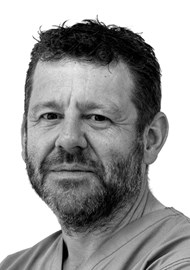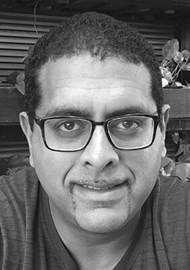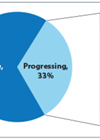Evolving technology, best practice and landmark evidence in glaucoma care were reviewed by an international expert faculty in session presentations and debates during the 11th Moorfields International Glaucoma Symposium 2019. The authors were meeting chairs and provide an overview of symposium proceedings.
OCT imaging and AI in ophthalmology
Hans Lemij, Rotterdam Eye Hospital, the Netherlands, discussed glaucoma optical coherence tomography (OCT) imaging and automated segmentation issues, noting several common image artefacts.
Paul Foster highlighted research by the UK Biobank Eye and Vision Consortium related to cognitive function and the expanding use of OCT imaging in dementia and neurodegeneration research. Findings show that a thinner retinal nerve fibre layer (RNFL) is associated with worse cognitive function in individuals without known neurodegenerative disease, as well as a greater likelihood of future cognitive decline [1]. The Rotterdam Study also revealed an association of retinal neurodegeneration on OCT with an increased risk of dementia, including Alzheimer’s disease [2]. Worsening vision in older adults may be adversely associated with future cognitive functioning, suggesting that maintenance of good vision may mitigate age-related cognitive decline [3]. For clinical practice, however, the use of OCT imaging to predict individual risk of cognitive decline has not yet been proven.
Sameer Trikha noted the rising burden of glaucoma care and new opportunities using artificial intelligence (AI). For validation, AI technology needs to be comprehensively tested across different devices, with clear explainability of algorithm results [4]. Future trends identified include use of AI machine learning tools to support clinical decision-making capabilities, development of transparency and trust, together with a changing clinician skill set entailing wider use of AI support.
Artificial intelligence is a fast-evolving technology that will likely lead to changes in ophthalmic clinical practice and AI-assisted science may provide new insights into disease, observed Pearse Keane. Nonetheless, robust prospective clinical validation of AI in ophthalmology is required. Intended uses of deep learning systems include initial clinical deployment as decision support tools, for example, in rapid access virtual macular clinics, as well as medical education and training applications [5]. Preliminary research results using deep learning to predict conversion from dry age-related macular degeneration (AMD) to neovascular (wet) AMD are promising.
New therapy for old problems: what will we be using in a decade?
Intraocular pressure (IOP) homeostasis is regulated within the trabecular meshwork / Schlemm’s canal, explained Daryl Overby, Imperial College London, in a review of the role of nitric oxide (NO) in the trabecular meshwork [6]. Increasing IOP stimulates NO production by Schlemm’s canal cells and NO may act as a mechanosensory feedback signal to decrease outflow resistance. Latanoprostene bunod (Vyzulta, Bausch+Lomb), approved in 2017 by the US Food and Drug Administration as a new treatment option for open-angle glaucoma (OAG) and ocular hypertension (OHT), is composed of latanoprost acid linked to a NO-donating moiety (butanediol mononitrate), providing a dual mechanism action through the uveoscleral and trabecular meshwork / Schlemm’s canal pathways to reduce elevated IOP [7].
Patrick Yu Wai Man discussed mitochondrial dysfunction, retinal ganglion cell (RGC) disease and potential therapeutic approaches. Retinal ganglion cell survival is critically dependent upon normal mitochondrial function. Mitochondrial optic neuropathies represent an important cause of chronic visual morbidity. Several promising treatment paradigms have emerged targeted at specific disease mechanisms, including stabilisation of the mitochondrial membrane and gene replacement therapy.
Jonathan G Crowston, University of Melbourne, Australia, explored visual recovery in glaucoma, including evidence that exercise boosts RGC recovery following injury. It is known that exercise is associated with improved cognitive function, while preliminary evidence suggests that vigorous physical activity may reduce glaucoma risk [8]. Animal studies show that exercise reverses age-related vulnerability of the retina to injury by preventing complement-mediated synapse elimination via a brain derived neurotrophin-dependent pathway [9]. Fry et al. outlined experimental research showing that functional recovery can occur following a prolonged course of RGC dysfunction [10]. Research also supports the therapeutic use of vitamin B3 in glaucoma and potentially other age-related neurodegenerative diseases [11].
Anthony Khawaja explained that genetics underlies IOP variability between individuals and that developmental and anatomical factors are important. Lymphangiogenic factors represent a potential treatment target. Collectively, loci have predictive value for primary open-angle glaucoma (POAG), underscoring the potential for targeted screening and prevention of late presentation with timely therapy [12]. Susan Williams, University of the Witwatersrand, Johannesburg, South Africa, said she believes that genetics will herald an era of precision medicine involving customised care for POAG, as new insights improve understanding of disease pathogenesis and the genetic factors that affect the risk of developing POAG (Table 1).

MIGS: where are we now?
Alex Huang, Doheny Eye Institute, USA, discussed advances in structural and functional evaluation of aqueous humour outflow (AHO). Impairment of AHO can lead to elevated IOP, optic nerve damage and concomitant glaucoma [13]. Assessment of AHO patterns after trabecular microbypass in glaucoma patients revealed different patterns of aqueous angiographic outflow improvement, although it is unclear which types portend better outcomes [14]. Greater understanding of AHO may prove useful in improving glaucoma surgeries aimed at trabecular meshwork bypass, with the aim of individualised surgery.
Compared with trabeculectomy using Mitomycin C (MMC), minimally invasive glaucoma surgery (MIGS) implantation produces a more predictable IOP gradient across the sclera, with less risk of hypotony, bleb leak, infection and discomfort, noted Professor Paul Palmberg, Bascom Palmer Eye Institute, USA. A prospective study showed surgery utilising the InnFocus microshunt (Santen) with MMC, alone or in combination with phacoemulsification, achieved IOP control in the low teens in most subjects up to three years’ post-surgery [15].
Achieving low IOP stabilises more people and may protect and help improve vision, noted Prof Palmberg. In the future, it may be possible to stage glaucoma patients and to evaluate treatment efficacy based on real-time assessment of neuronal cell apoptosis [16]. Cordeiro et al. recently demonstrated that the level of apoptosis (detected using, detecting apoptosing retinal cells (DARC) in vivo) correlated with glaucoma, increased glaucoma progression, decreased central corneal thickness and increasing age [16].
Herbert A Reitsamer, University Clinic Salzberg, Austria, shared his experience with ab interno XEN implant (Allergan) surgery for lowering of IOP in glaucoma. He said the most important considerations in determining which patients are suitable for a XEN procedure are target IOP, tolerance to eye drops, anatomical considerations and whether cataract surgery is necessary. Results from the APEX study group showed that the XEN implant, with or without phacoemulsification, effectively reduced IOP and need for medication over two years in POAG uncontrolled medically [17]. Professor Norbert Pfeiffer, Mainz University Medical Center, Germany, discussed glaucoma surgery using the Hydrus Microstent (Ivantis). At 24 months in the HORIZON study, the proportion of POAG subjects achieving a 20% reduction from baseline in washed-out modified diurnal IOP was 77.2% in the cataract surgery plus Hydrus Microstent group (n=369) versus 57.8% in the phaco only group (n=187), difference 19.5% (P<0.001) [18].
Paul Harasymowycz, University of Montreal, Canada, provided a personal viewpoint on choice of MIGS devices. He suggested that for patients well controlled on antiglaucoma medications but who wanted to get off topical drops, he would probably choose a MIGS procedure.
With the rapid adoption of MIGS as primary surgery for glaucoma, there is a need for assessment of patient-centric outcomes in studies of MIGS devices to complement randomised clinical trial data, observed Nathan Kerr [19]. The International Glaucoma Surgery Registry provides a secure, web-based clinical tool for ophthalmologists to track and audit surgical as well as patient-reported outcomes (migs.org/registry). The registry has seen rapid take-up, with users in over 20 countries.
Keith Barton described device enhancements aimed at improved insertion and placement and continuing MIGS developments. Investigational MIGS device iStent inifite (Glaukos), comprising three heparin-coated trabecular bypass stents preloaded into an auto injection system, is designed to be less invasive, allow faster recovery and have fewer complications than conventional procedures. Novel glaucoma surgery devices and alternative drug delivery systems in the pipeline include MINIject (iSTAR Medical), the MIMS ab-interno procedure (Sanoculis), iDOSE travoprost (Glaukos) and bimatoprost sustained release (SR) intracameral implant (Allergan). iDOSE travoprost is a titanium implant designed for continuous drug delivery directly into the anterior chamber; preliminary phase II data show average IOP reductions of more than 30% from baseline through 12 months.
The Debates
Debate discussions addressed pre-perimetric glaucoma, phasing of diurnal IOP, use of intravitreal bevacizumab for non-neovascular glaucoma surgery and the impact of glaucoma surgery on the corneal endothelium.
Prof Paul Palmberg underscored the benefit of detecting structural loss before visual field damage, supporting close follow-up and monitoring of pre-perimetric glaucoma. Visual fields are notoriously variable, while OCT RNFL loss is highly predictive of functional loss.
Philip Bloom, Western Eye Hospital, London, argued that monitoring of diurnal IOP during follow-up of glaucoma is inconvenient, costly, may delay clinical decision-making and is of little or no proven utility. Phasing with all day measurements of eye pressure may be appropriate and useful in a number of different case scenarios, explained Debbie Kamal. For example, to establish a diagnosis in normal tension glaucoma, to differentiate between a suspect and ‘likely’ glaucoma or where there is progression or disc haemorrhage despite controlled clinic IOP. Phasing validates the management regime and patients are the winners with respect to tailored treatment, concluded Ms Kamal.
Vascular endothelial growth factor (VEGF) is a major driver of scar formation. Adjunctive intravitreal bevacizumab inhibits fibrosis and will help improve outcomes in certain individuals at higher risk of excess fibrosis, observed Mr Crowston. Alex Huang commented that anti-VEGF treatment changes blebs, that anti-scarring measures are available and attention should be focused on promoting outflow.
Landmark trials
The Zhongshan Angle Closure Prevention (ZAP) and Effectiveness in Angle-closure Glaucoma of Lens Extraction (EAGLE) trials have helped define optimal management of primary angle closure glaucoma (PACG), explained Mr Foster. The ZAP trial found that prophylactic peripheral iridotomy (PI) in primary angle closure suspects (PACS) had no proven benefit over the planned three-year trial, although there was a significant but modest benefit over six years. Trial investigators concluded that PI should only be offered to suspects with the very highest risk of PACG. Table 2 details estimates of the number of people with glaucoma worldwide.

The EAGLE trial demonstrated the effectiveness of early clear lens extraction for the treatment of PACG (Table 3)[20]. Investigators recommended lens extraction as the preferred initial intervention for high IOP PAC/PACG [20]. Mean postoperative corrected distance visual acuity in patients undergoing lens extraction for angle closure glaucoma appeared stable over the three-year study period [21].
Gus Gazzard reviewed findings from the LiGHT randomised study, which assessed initial selective laser trabeculoplasty (SLT) followed by conventional medial therapy as required versus conventional medical therapy without laser in newly diagnosed OAG and OHT patients [22]. At three years’ follow-up, initial SLT provided drop-free disease control at stringent target IOPs in three-quarters of patients, with lower surgery and glaucoma progression rates compared with the medicine-first group. Results suggest that primary SLT should be considered for all newly diagnosed patients with POAG or OHT (Table 4). Further studies might consider more sensitive quality of life instruments, with bolt-on studies of additional risk factors such as ocular surface disease.
The UK Glaucoma Treatment Study (UKGTS) represents the first placebo-controlled trial to show preservation of the visual field with an IOP-lowering drug in patients with OAG [23]. Ted Garway-Heath considered that future protocols of studies of disease progression in glaucoma should evaluate visual field progression using rate-based analysis as the primary outcome, with secondary outcomes capturing spectral domain OCT features and quality of life measures. Combining OCT and visual field data can more rapidly identify worsening vision and produce more accurate estimates of the progression rate than visual field-only methods [24].
The Primary Tube Versus Trabeculectomy Study (PTVT) demonstrated a higher surgical success rate for trabeculectomy with MMC compared with tube shunt implantation in patients with medically uncontrolled glaucoma and no previous incisional ocular surgery [25]. Tube shunt surgery had a higher success rate compared with augmented trabeculectomy during five years of follow-up in the Tube Versus Trabeculectomy (TVT) study [26]. Surgical techniques and different baseline characteristics may partly explain outcome differences between these trials, noted Sheng Lim. The randomised single-centre PEACE trial will evaluate trabeculectomy with MMC versus Baerveldt tube implantation with or without MMC in black African Caribbean or African adults with POAG that is uncontrolled on tolerated medical therapy.
The Treatment of Advanced Glaucoma Study (TAGS), a multicentre randomised controlled trial comparing primary medical treatment with primary trabeculectomy for people with newly diagnosed advanced glaucoma, is expected to report two-year results in 2020 [27]. Anthony King, Nottingham University Hospital, Nottingham, emphasised that subjects with greater visual field loss at presentation face an increased risk of bilateral glaucoma blindness [28]. The TAGS trial will help address current uncertainty between guidelines and ophthalmology practice regarding the best initial treatment option for people with severe glaucoma.
Back to basics
W Daniel Stamer, Duke University, USA, reviewed the ocular pharmacology of topical drug administration and future glaucoma therapeutics, including sustained drug delivery systems. Topical application of medication is an inefficient route of administration, the corneal epithelium being the primary barrier to ocular entry for drops. Dosing frequency depends on lipophilicity of the drug and its ability to depot in relevant tissues. A single bimatoprost sustained release implant (Allergan) has been shown to control IOP up to 16 weeks in 91% of patients and for six months in 71% of patients [29].
Kazuo Tsubota, Keio University School of Medicine, Japan, explained that glaucoma eye drops decrease tearing, resulting in dry eye. A prospective crossover trial in healthy subjects highlighted the negative effects of antiglaucoma medication and its preservatives on the corneal tear film, effects that worsen with increasing drop instillation [30]. Latanoprost showed the most statistically significant reduction in break-up time, and brimonidine showed the most significant reduction in basal secretion of all the glaucoma medications used in this study [30]. Although the precise mechanism of reduced tearing is not clear yet, a neuronal approach may reveal the real mechanism of lowering tear production by topical glaucoma medications.
The global market withdrawal of the CyPass micro-stent over concerns of endothelial cell loss has highlighted broader considerations with respect to the corneal endothelium and glaucoma surgery. Leon Au, Manchester Royal Eye Hospital, Manchester, explained that pre-existing glaucoma has a significantly higher risk of corneal graft failure. There is evidence that glaucoma patients have a lower corneal endothelial cell count than normal controls [31], which is most likely IOP related. Mr Au stressed the importance of considering the impact of surgery on the cornea. Tube drainage implantation is associated with endothelial cell density loss of between 11.5% and 18.6% [32,33].
Martin Watson also emphasised considerations with respect to the epithelium, encouraging glaucoma specialists to minimise drops and minimise preservative use. Endothelial risk should also be considered when planning glaucoma surgery.
W Daniel Stamer reviewed the acute transient effects of intravitreal anti-VEGF injection therapy on IOP [34]. Approximately ~6% of non-POAG/OHT patients receiving repeated anti-VEGF injections will develop sustained ocular hypertension, with OHT patients being particularly susceptible to sustained IOP elevation (>6-8mmHg) after anti-VEGF injections [35]. Brad Fortune, Devers Eye Institute, USA, explained that glaucoma exerts a mechanical impact on the retina and proposed a role for optic nerve head deformation. Manifestations include paravascular inner retinal defects / paravascular defects, peripapillary retinoschisis and inner nuclear layer pseudo-cysts. Peripapillary retinoschisis is associated with existing RNFL defects and faster progression, while inner nuclear layer pseudo-cysts are associated with moderate to severe loss and rapid progression.
References
1. Ko F, Muthy ZA, Gallacher J, et al; UK Biobank Eye & Vision Consortium. Association of retinal nerve fiber layer thinning with current and future cognitive decline: a study using optical coherence tomography. JAMA Neurol 2018;75(10):1198-205.
2. Mutlu U, Colijn JM, Ikram MA, et al. Association of retinal neurodegeneration on optical coherence tomography with dementia: a population-based study. JAMA Neurol 2018;75(10):1256-63.
3. Zheng DD, Swenor BK, Christ SL, et al. Longitudinal associations between visual impairment and cognitive functioning: the Salisbury Eye Evaluation Study. JAMA Ophthalmol 2018;136(9):989-95.
4. Ting DSW, Pasquale LR, Peng L, et al. Artificial intelligence and deep learning in ophthalmology. Br J Ophthalmol 2019;103(2):167-75.
5. De Fauw J, Ledsam JR, Romera-Paredes B, et al. Clinically applicable deep learning for diagnosis and referral in retinal disease. Nat Med 2018;24(9):1342-50.
6. Chandrawati R, Chang JYH, Reina-Torres E, et al. Localized and controlled delivery of nitric oxide to the conventional outflow pathway via enzyme biocatalysis: toward therapy for glaucoma. Adv Mater 2017;29(16).
7. Cavet ME, DeCory HH. The role of nitric oxide in the intraocular pressure lowering efficacy of latanoprostene bunod: review of nonclinical studies. J Ocul Pharmacol Ther 2018;34(1-2):52-60.
8. Williams PT. Relationship of incident glaucoma versus physical activity and fitness in male runners. Med Sci Sports Exerc 2009;41(8):1566-72.
9. Chrysostomou V, Galic S, van Wijngaarden P, et al. Exercise reverses age-related vulnerability of the retina to injury by preventing complement-mediated synapse elimination via a BDNF-dependent pathway. Aging Cell 2016;15(6):1082-91.
10. Fry LE, Fahy E, Chrysostomou V, et al. The coma in glaucoma: Retinal ganglion cell dysfunction and recovery. Prog Retin Eye Res 2018;65:77-92.
11. Williams PA, Harder JM, Foxworth NE, et al. Vitamin B3 modulates mitochondrial vulnerability and prevents glaucoma in aged mice. Science 2017;355(6326):756‑60.
12. Khawaja AP, Cooke Bailey JN, Wareham NJ, et al; UK Biobank Eye and Vision Consortium; NEIGHBORHOOD Consortium. Genome-wide analyses identify 68 new loci associated with intraocular pressure and improve risk prediction for primary open-angle glaucoma. Nat Genet 2018;50(6):778-82.
13. Huang AS, Francis BA, Weinreb RN. Structural and functional imaging of aqueous humour outflow: a review. Clin Exp Ophthalmol 2018;46(2):158-68.
14. Huang AS, Penteado RC, Papoyan V, et al. Aqueous angiographic outflow improvement after trabecular microbypass in glaucoma patients. Ophthalmology Glaucoma 2019;2:11-21.
15. Batlle JF, Fantes F, Riss I, et al. Three-year follow-up of a novel aqueous humor microshunt. J Glaucoma 2016;25(2):e58-65.
16. Cordeiro MF, Normando EM, Cardoso MJ, et al. Real-time imaging of single neuronal cell apoptosis in patients with glaucoma. Brain 2017;140(6):1757-67.
17. Reitsamer H, Sng C, Vera V, et al; Apex Study Group. Two-year results of a multicenter study of the ab interno gelatin implant in medically uncontrolled primary open-angle glaucoma. Graefes Arch Clin Exp Ophthalmol 2019 [Epub ahead of print].
18. Samuelson TW, Chang DF, Marquis R, et al; HORIZON Investigators. A Schlemm canal microstent for intraocular pressure reduction in primary open-angle glaucoma and cataract: the HORIZON study. Ophthalmology 2019;126(1):29-37.
19. Kerr NM, Wang J, Barton K. Minimally invasive glaucoma surgery as primary stand-alone surgery for glaucoma. Clin Exp Ophthalmol 2017;45(4):393-400.
20. Azuara-Blanco A, Burr J, Ramsay C, et al; EAGLE study group. Effectiveness of early lens extraction for the treatment of primary angle-closure glaucoma (EAGLE): a randomised controlled trial. Lancet 2016;388(10052):1389-97.
21. Day AC, Cooper D, Burr J, et al. Clear lens extraction for the management of primary angle closure glaucoma: surgical technique and refractive outcomes in the EAGLE cohort. Br J Ophthalmol 2018;102(12):1658-62.
22. Gazzard G, Konstantakopoulou E, Garway-Heath D, et al; LiGHT Trial Study Group. Selective laser trabeculoplasty versus eye drops for first-line treatment of ocular hypertension and glaucoma (LiGHT): a multicentre randomised controlled trial. Lancet 2019;393(10180):1505-16.
23. Garway-Heath DF, Crabb DP, Bunce C, et al. Latanoprost for open-angle glaucoma (UKGTS): a randomised, multicentre, placebo-controlled trial. Lancet 2015;385(9975):1295-304.
24. Garway-Heath DF, Zhu H, Cheng Q, et al. Combining optical coherence tomography with visual field data to rapidly detect disease progression in glaucoma: a diagnostic accuracy study. Health Technol Assess 2018;22(4):1-106.
25. Gedde SJ, Feuer WJ, Shi W, et al; Primary Tube versus Tabeculectomy study group. Treatment outcomes in the primary tube versus trabeculectomy study after 1 year of follow-up. Ophthalmology 2018;125(5):650-63.
26. Gedde SJ, Schiffman JC, Feuer WJ, et al; Tube versus Trabeculectomy Study Group. Treatment outcomes in the Tube Versus Trabeculectomy (TVT) study after five years of follow-up. Am J Ophthalmol 2012;153(5):789‑803.
27. King AJ, Fernie G, Azuara-Blanco, et al. Treatment of Advanced Glaucoma Study: a multicentre randomised controlled trial comparing primary medical treatment with primary trabeculectomy for people with newly diagnosed advanced glaucoma-study protocol. Br J Ophthalmol 2018;102(7):922-8.
28. Peters D, Bengtsson B, Heijl A. Factors associated with lifetime risk of open-angle glaucoma blindness. Acta Ophthalmol 2014;92(5):421-5.
29. Lewis RA, Christie WC, Day DG, et al; Bimatoprost SR Study Group. Bimatoprost sustained-release implants for glaucoma therapy: 6-month results from a Phase I/II clinical trial. Am J Ophthalmol 2017;175:137-47.
30. Terai N, Müller-Holz M, Spoerl E, Pillunat LE. Short-term effect of topical antiglaucoma medication on tear-film stability, tear secretion, and corneal sensitivity in healthy subjects. Clin Ophthalmol 2011;5:517-25.
31. Gagnon MM, Boisjoly HM, Brunette I, et al. Corneal endothelial cell density in glaucoma. Cornea 1997;16(3):314-8.
32. Nassiri N, Nassiri N, Majdi-N M, et al. Corneal endothelial cell changes after Ahmed valve and Molteno glaucoma implants. Ophthalmic Surg Lasers Imaging 2011;42(5):394-9.
33. Lee EK, Yun YJ, Lee JE, et al. Changes in corneal endothelial cells after Ahmed glaucoma valve implantation: 2-year follow-up. Am J Ophthalmol 2009;148(3):361-7.
34. Hoguet A, Chen PP, Junk AK, et al. The effect of anti-vascular endothelial growth factor agents on intraocular pressure and glaucoma: a report by the American Academy of Ophthalmology. Ophthalmology 2019;126(4):611-622.
35. Bakri SJ, Moshfeghi DM, Francom S, et al. Intraocular pressure in eyes receiving monthly ranibizumab in 2 pivotal age-related macular degeneration clinical trials. Ophthalmology 2014;121(5):1102-8.
Declaration of competing interests:
KB has received grants from the National Institute for Health Research as a member of the LiGHT Trial and TAGS trial study groups. KB has received grants from AMO, New World Medical, Alcon, Merck, Allergan, Refocus; has participated on advisory boards for Alcon, Merck, Refocus, Ivantis, Kowa, Glaukos, Amakem, pH Pharma, EyeD Pharma and Laboratoires Thea; has received honoraria for lecturing from Allergan, Alcon, and Pfizer; has been a consultant for Alcon, Aquesys, Ivantis, Refocus, Carl Zeiss Meditec, Kowa, Santen, Radiance Therapeutics and Transcend Medical; and has stock in Aquesys, Vision Futures Ltd, London Claremont Clinic Ltd, Vision Medical Events Ltd and International Glaucoma Surgery Registry Ltd. KB also has had a patent issued related to Advanced Ophthalmic Innovations.
GG has received a grant from the National Institute for Health Research as a member of the LiGHT Trial study group. GG has received grants from Lumenis, Ellex, Ivantis and Thea; and personal fees from Allergan, Alcon, Glaukos, Santen, and Thea.
HJ declared consultant / advisory role with Allergan and honoraria from Santen, Allergan and Laboratories Thea.
Acknowledgements:
The article summarises principal session presentations and debates from the 11th Moorfields International Glaucoma Symposium, 26-27 January 2019, Royal College of Physicians, London, UK. The meeting was supported by an educational grant from Thea Pharmaceuticals. Symposium meeting chairs Keith Barton, Gus Gazzard and Hari Jayaram reviewed an initial draft manuscript and approved the final article for publication submission. Medical writing support was provided by Rod McNeil Associates and was funded by Thea Pharmaceuticals.
COMMENTS ARE WELCOME











